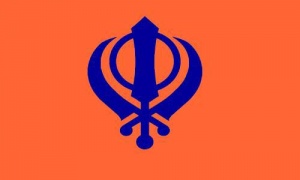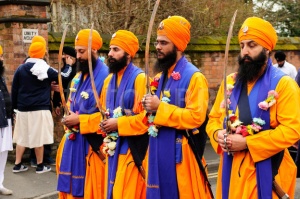Caste
|
Sikhism does not endorse caste based distinctions in society that lead to unequal opportunities for some people. In fact, Sikhism completely rejects class or race based distinctions between humans, that leads us to make an inequitable society. Such distinctions have surfaced only due to ill interests of certain section of people, who, on the pretext of making a society more manageable through these classifications, eventually paved the way to an unequal grouping within the human race. This article is just for information purpose and to share how people from different castes came into the Sikh fold. So, please treat this article as a source of general information about this issue and kindly do not amend this article to highlight this important underlying Sikh principle. If you have any comments, please discuss them appropriately here |
Caste or Caste systems are hereditary systems of social class in many parts of the world. This classification is based on social occupation, endogamy, social class, and social group.
Sikhism does not endorse caste based distinctions in society that lead to unequal opportunities for some people. In fact, Sikhism completely rejects class or race based distinctions between humans, that leads us to make an inequitable society. Such distinctions have surfaced only due to ill interests of certain section of people, who, on the pretext of making a society more manageable through these classifications, eventually paved the way to an unequal grouping within the human race.
Sikh Caste System
14 Castes in Sikhism - Waheguru Ji Ka Khalsa Waheguru Ji Ki Fateh
Caste is a form of social stratification characterized by endogamy, non-commensality and hereditary occupations, A paradigmatic, ethnographic example is the division of Indian society into social groups.
There are at least two perspectives for the origins of the caste system in ancient and medieval India. One focuses on the ideological factors which are claimed to drive the caste system and holds that caste rooted in the four varnas. This perspective was particularly common among scholars, who concluded that the system was ideologically perfected several thousand years ago and has remained the primary social reality ever since. This school justifies its theory primarily by citing Manusmriti and it disregards economic, political or historical evidence.
- 1st Sikh Rajput - First Place in Caste System
- 2nd Sikh Kamboj - Second Place in Caste System
- 3rd Sikh Kumhar - Third Place in Caste System
- 4th Sikh Khatri - Fourth Place in Caste System
- 5th Sikh Nai - Fifth Place in Caste System
- 6th Sikh Ravidasi - Sixth Place in Caste System
- 7th Sikh Ramgarhia - Seventh Place in Caste System
- 8th Sikh Bhatra - Eighth Place in Caste System
- 9th Sikh Arora - Ninth Place in Caste System
- 10th Sikh Agrawal - Tenth Place in Caste System
- 11th Sikh Bania - Eleventh Place in Caste System
- 12th Sikh Sindhi - Twelfth Place in Caste System
- 13th Sikh Jatt - Fourteenth Place in Caste System
- 14th Sikh Ramdasia - Fifteenth in Caste System
Religious Prohibition in Caste System
As per Caste System described in Manu Smriti, Shudra are considered as lowest caste and untouchable. The post-Vedic texts, particularly Manusmriti mentions outcastes and suggests that they be ostracized. They are:
- Not required to observe any Vedic Rituals,
- Not allowed to Study Vedas,
- Not allowed to hear Sacred Chants of Vedas,
- Not allowed to eat food with High Castes,
- Not allowed to drink water from where High Caste fetch,
- Not allowed to marry high castes,
- Even high caste marry with them; that person gets outcaste,
- Stay away from homes of high caste people.
- Introducing belief that low caste people did bad Karma in Past lives.
- More Fine payments by Lower castes in case of Crime.
- Severe punishment to lower caste if he hurt high caste people but vice versa is not true.
This system was forced on people by various Rigid Hindu Kings; who seek advice of Orthodox Brahmins; whom they respect the most and appointed as ministers. This lead to Exploitation of Weak, Disunity and Division of Loyalities, Foreign Domination, No Healthy exchange of knowledge and ideas, Untouchability and Low Self esteem.
Sikh Heritage Colours
Blue and Orange - Sikh Colours, Khalsa Colours
Guru Gobind Singh and Khalsa
Guru Gobind Singh established Khalsa on will of Supreme. The 5 person are chosen to lead the Sikh Community; who will take all decisions related to Sikh and will protect Gurmat from any foreign intrusion. All 5 were belong to different caste, were given Pahul in Single utensil and named as Khalsa. There is no belief of Caste System in Khalsa. Every one is open for attaining Spiritual Knowledge.


